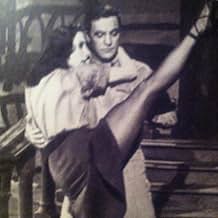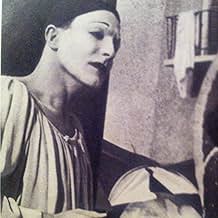Invitation to the Dance
- 1956
- 1 घं 33 मि
IMDb रेटिंग
6.4/10
1.1 हज़ार
आपकी रेटिंग
अपनी भाषा में प्लॉट जोड़ेंThree different stories are told through a notably unusual way - no words, just dance.Three different stories are told through a notably unusual way - no words, just dance.Three different stories are told through a notably unusual way - no words, just dance.
- निर्देशक
- लेखक
- स्टार
- पुरस्कार
- 1 जीत और कुल 1 नामांकन
Luigi Faccuito
- Specialty Dancer
- (बिना क्रेडिट के)
Diki Lerner
- Thief in 'Sinbad the Sailor'
- (बिना क्रेडिट के)
Paddy Stone
- Speciality Dancer
- (बिना क्रेडिट के)
Ian Wilson
- Man Exiting Stage Door in 'Ring Around the Rosy'
- (बिना क्रेडिट के)
फ़ीचर्ड समीक्षाएं
this was Kelly's pet project- a film with dance, and only dance. No dialogue, only mime, movement and music. However to his disappointment, MGM shelved its release and when it was the film was released badly- it was too arty farty to be popular with the audiences at that time. Well, I love this film. It's adventurous and interesting, and it's worth a watch to appreciate all the work Kelly's put into this work, which showcases some of the greatest dancers across many styles. So go watch this under-rated film and you will be in awe of all the talent shown before your eyes!
It might better have been called "Invitation to the Pantomime" because there is no speaking, much less singing, in the film, a production much better suited to the stage. The movie does in fact look like a filmed stage production, and the format and ambitions of the film are not what audiences had come to expect from Gene Kelly. But this was his baby, and he wanted to take filmed dance to entirely new levels of artistic achievement. In many ways, it is a testimony to his power as a choreographer and a star that he was able to pull it off. Nevertheless, beautiful as it is, this is not everyone's cup of tea. Watching the first of the three dance sequences, I longed for Kelly to take that white paint off his mime face and stop mooning over the ballerina. He did, and the next two sequences are more enjoyable, the last being rather fun when animation takes over. ---from Musicals on the Silver Screen, American Library Association, 2013
Invitation to the Dance is what you get when you take an artist at the peak of his abilities and allow his imagination to run wild. Gene Kelly--and some very talented people in all fields--integrated music and dance to create three distinct stories.
He reduces some scenes to their visual essences by using abstract or minimalist sets, aided by lighting effects. The third story includes cartoons, allowing Kelly to take his imagination beyond the bounds of human limitations and physics.
The performances are a synthesis of various dance and related forms (ballet, tap, jazz, mime, acrobatics, pop, and ethnic) with musical accompaniment (classical, jazz--cool and hot--ethnic, and pop).
Invitation to the Dance is a treat for any dance lover. It should be seen by all young students of dance.
It would be interesting to see this film they way Kelly originally imagined it, with him dancing in one section only.
He reduces some scenes to their visual essences by using abstract or minimalist sets, aided by lighting effects. The third story includes cartoons, allowing Kelly to take his imagination beyond the bounds of human limitations and physics.
The performances are a synthesis of various dance and related forms (ballet, tap, jazz, mime, acrobatics, pop, and ethnic) with musical accompaniment (classical, jazz--cool and hot--ethnic, and pop).
Invitation to the Dance is a treat for any dance lover. It should be seen by all young students of dance.
It would be interesting to see this film they way Kelly originally imagined it, with him dancing in one section only.
No wonder INVITATION TO THE DANCE found no audience at the box office. The first two musical sequences, "Circus" and "Ring Around the Rosy" are monumental bores dragged down by pedestrian stories and, in the second one, inept use of camera trickery to speed up the action.
But the third, "Sinbad the Sailor," makes expert use of the Rimsky-Korsakov ballet score and makes dazzling use of animated effects, especially for the dancing between Kelly and a couple of Arabian guards which are highly original, intricate and amusing examples of combining live action with animation. It's the kind of originality sadly missing in the previously mentioned stories.
The "Sinbad" highlight almost makes up for the rest of the film with its own brand of originality--but alas, the first two sequences are enough to turn many viewers away from watching the final segment.
Summing up: Easy to see why this one failed miserably to attract a target audience with either high or low brow tastes.
But the third, "Sinbad the Sailor," makes expert use of the Rimsky-Korsakov ballet score and makes dazzling use of animated effects, especially for the dancing between Kelly and a couple of Arabian guards which are highly original, intricate and amusing examples of combining live action with animation. It's the kind of originality sadly missing in the previously mentioned stories.
The "Sinbad" highlight almost makes up for the rest of the film with its own brand of originality--but alas, the first two sequences are enough to turn many viewers away from watching the final segment.
Summing up: Easy to see why this one failed miserably to attract a target audience with either high or low brow tastes.
The first two segments of this film may or may not impress you, but do watch the third: "Sinbad the Sailor". Kelly plays an American sailor in an exotic Oriental market. He rubs an old lamp and a genie appears, played by an amazingly talented kid. After a bit of messing around,the genie gets a sailor suit, too. Then they open a book to a picture of a wonderous land. The genie transports them inside and all the rest features the two dancers (mostly Kelly alone) dancing with animation.This segment is much longer than any other live-plus-animation sequence until Mary Poppins excepting, possibly Song of the South whose sequences were nowhere near so complex as this. Kelly dances with an animated dragon (that wraps around him), into a harem, is chased by the Sultan's guards, has a long sequence with one harem girl, and then a very long sequence with the guards. This is amazing work for 1952, especially when you remember that every bit of the animation is hand-painted on cels. Hanna-Barbera (then with MGM doing Tom and Jerry directed the animation. (Kelly also did a famous dance number with Jerry in Anchors Aweigh eight years earlier.) Walt Disney advised. This is swell stuff and any fan of animation should give it a look.
क्या आपको पता है
- ट्रिवियाGene Kelly's original intention was to make a film that would educate mainstream audiences about professional dancing in the world. To this end, he wanted to cast the greatest dancers in Europe for the four segments in leading roles. He himself would appear in only one - the Popular Song sequence, which ended up being cut. MGM, however, refused to allow the picture unless he appeared in all of them. Many of the professionals who worked in the film agreed that this was one of the film's great weaknesses.
- गूफ़During the "Scheherazade" sequence, the color of the palace guard's costume changes from green to blue.
- कनेक्शनEdited into American Masters: Gene Kelly: Anatomy of a Dancer (2002)
- साउंडट्रैकCircus
Music by Jacques Ibert
Performed by The Royal Philharmonic Orchestra, conducted by John Hollingsworth
Danced by Gene Kelly, Igor Youskevitch and Claire Sombert
टॉप पसंद
रेटिंग देने के लिए साइन-इन करें और वैयक्तिकृत सुझावों के लिए वॉचलिस्ट करें
- How long is Invitation to the Dance?Alexa द्वारा संचालित
विवरण
बॉक्स ऑफ़िस
- बजट
- $15,00,000(अनुमानित)
- चलने की अवधि1 घंटा 33 मिनट
- पक्ष अनुपात
- 1.37 : 1
इस पेज में योगदान दें
किसी बदलाव का सुझाव दें या अनुपलब्ध कॉन्टेंट जोड़ें

































